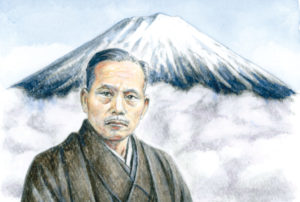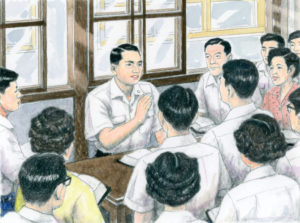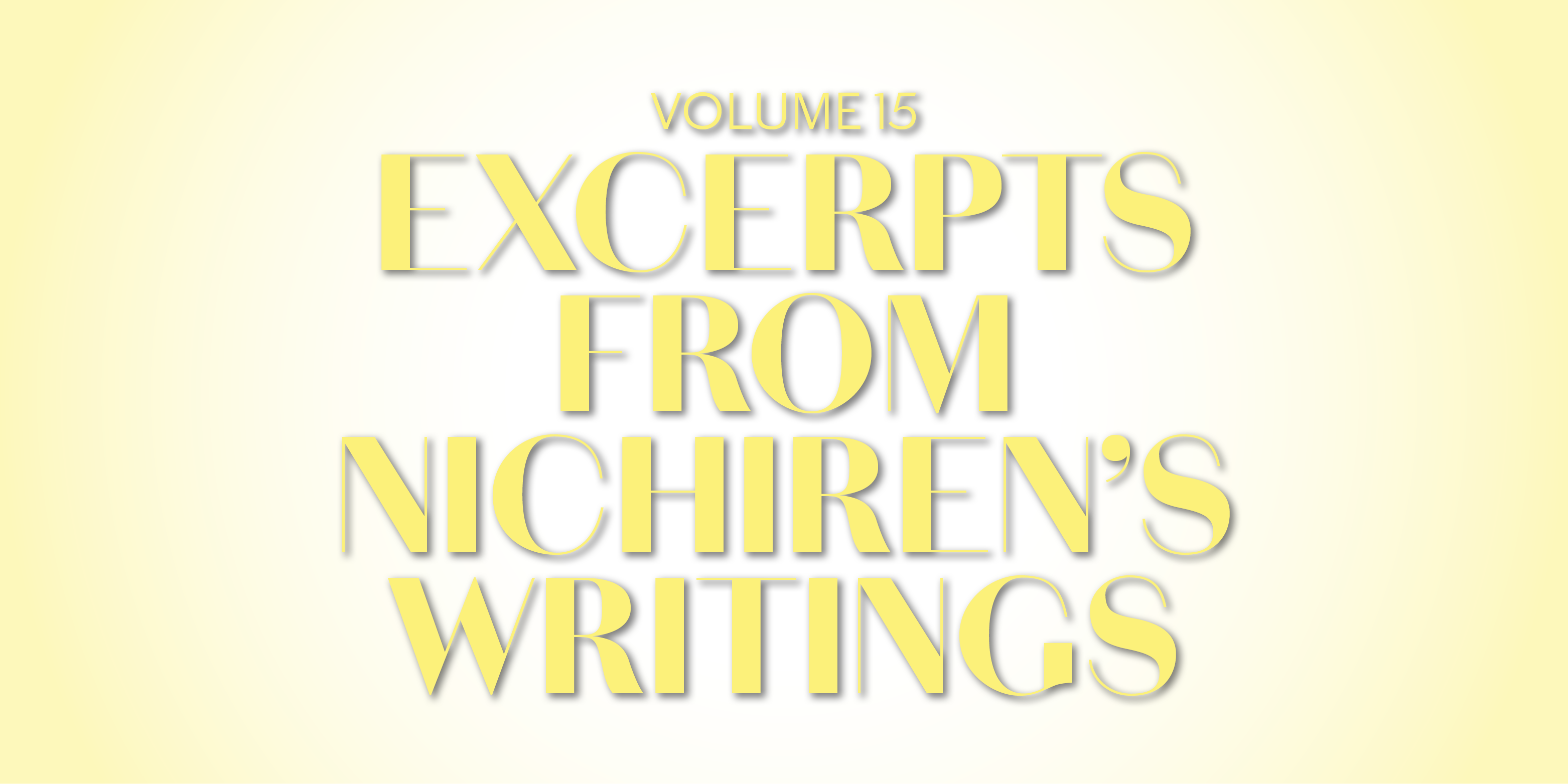This installment, published in the January 22, 2019, issue of the Seikyo Shimbun, focuses on passages from Nichiren Daishonin’s writings that Ikeda Sensei discusses in volume 15 of The New Human Revolution.
Passage 1
“By offering their lives to the Lotus Sutra, they became Buddhas.” (“On Namu,” The Writings of Nichiren Daishonin, vol. 2, p. 1073)
Spreading Buddhism to the Very End

Illustration courtesy of Seikyo Press.
When an informal discussion with student division members went from Yukio Mishima, the acclaimed writer who committed suicide for his beliefs, to the Buddhist view of devoting one’s life, Shin’ichi Yamamoto shared the following thoughts.
“So how should we use our lives? Nichiren concludes that we should use them for the sake of the Lotus Sutra … By devoting ourselves to the Lotus Sutra—to the correct teaching and to kosen-rufu—we establish the state of Buddhahood, of absolute happiness, in our lives. This is also the direct path to leading all people to happiness.
“To give one’s life does not necessarily mean dying. It means struggling with all our might in the effort to achieve kosen-rufu. Some of us may die in that process, such as the three martyrs of Atsuhara or first Soka Gakkai President Tsunesaburo Makiguchi. At the same time, however, ‘devoting one’s life’ means working to fulfill our mission for kosen-rufu throughout our lives, taking action and telling others about Buddhism to the very end.
“The point is to strive to win each day, always asking ourselves if we did our best, if we compromised our beliefs, if we have any regrets. Those who do so are ‘devoting their life’ … ”
The students listened intently as Shin’ichi continued: “When I was younger, I recorded this determination in my diary: ‘Revolution is death. Our death will be our devotion to the Mystic Law.’ This was the moment I decided that I would dedicate my life to kosen-rufu and President Toda …
“From that moment, my commitment has never wavered, no matter what obstacles or threats I encountered. In fact, in such determination lies the path to achieving one’s own human revolution and a state of absolute happiness.” (The New Human Revolution, vol. 15, pp. 52–54)
Passage 2
“It must be ties of karma from the distant past that have destined you to become my disciple at a time like this.” (“The Heritage of the Ultimate Law of Life,” WND-1, 217)
Awakening to Our Eternal Mission

Illustration courtesy of Seikyo Press.
In August 1955, during the Sapporo Summer Propagation Campaign, Shin’ichi Yamamoto shares the following encouragement based on a passage from The Writings of Nichiren Daishonin, instilling courage in the members’ hearts.
“These words describe the deep connection between Nichiren and his disciples who struggled alongside him. As such, it applies equally to us, who have inherited his spirit and are devoting our lives to kosen-rufu.
“The fact that all of us were born at this time and have gathered together now to unite our efforts in this campaign is the result of deep ties forged in the past. It is no accident. We promised Nichiren in a previous existence that we would carry out kosen-rufu. And in order to do so, some of us volunteered to be born poor and some to lead a life of illness.
“The place and time that we chose in the past to begin our great struggle is none other than Sapporo, Hokkaido, in August 1955. You have all assembled here to participate in this great campaign so that you can change your karma of poverty or illness and demonstrate the greatness of the Mystic Law. If you are firmly aware of this, you cannot fail to exhibit tremendous ability. With the Gohonzon, we will never be deadlocked. Let us fight with zest and high spirits!” …
As [the Sapporo members] listened to him speak, they realized that their mission stemmed from the remote past and were thrilled to participate in this historic struggle that would determine the future of kosen-rufu. They rose to the challenge, their excitement fueling their efforts. (NHR-15, “Revitalization” chapter, 66–67)
Sea of Suffering Into the Seaside Buddha Land
The “Revitalization” chapter in volume 15 of The New Human Revolution details how Soka Gakkai members stood up amid the Minamata disease epidemic.
The Minamata disease was a pollution-related illness that emerged in Minamata, Kumamoto prefecture, caused by a chemical plant releasing mercury-contaminated waste into the ocean. The waste accumulated in the marine life, and people who ate the contaminated seafood experienced a series of neurological disorders and symptoms.
Outraged by this situation, SGI President Ikeda set about writing two essays on the subject of pollution. He also met with researchers studying the pollution problem and learned everything he could about the issue.
In August 1972, President Ikeda met with Jun Ui, a leading figure in environmental research, engaging in a six-hour discussion on how to approach the issue of pollution.
At their meeting, Mr. Ui stated: “When we become the hands and feet of the victims and work on their behalf, the wisdom to find a solution will well forth. But if we separate ourselves from the common people, our learning will end.” This belief of “together with the common people” deeply resonates with President Ikeda’s own conviction, and is the fundamental spirit of the Soka Gakkai.
Victims and their family members faced prejudice and were robbed of their lives. The suffering and anger they had to endure because of the careless pollution is immeasurable. Amid this “sea of suffering,” the Soka Gakkai members of Minamata lived out their lives, dedicating themselves to the happiness of their friends.
President Ikeda composed the poem:
May my friends in Minamata
be happy and live long,
enjoying their present existence
in their seaside Buddha land.
To transform one’s beloved hometown from the “sea of suffering” into the “seaside Buddha land”—there is no doubt that this path of revitalization, paved by friends in Minamata, is giving people all over the courage to live.
You are reading {{ meterCount }} of {{ meterMax }} free premium articles

